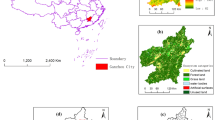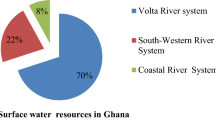Abstract
Water supply services (WSSs) are critical for the regional water balance and water circulation, but relevant studies have not established the relationship between WSSs and human well-being. This research identifies the scope of areas that benefit from WSSs from an ecosystem service flow perspective. Moreover, the path and quantity of the flow of WSSs are simulated to provide a scientific theoretical basis for ecosystem service management and ecological compensation. The Dongjiang Lake Basin is a national priority river basin in China where ecological compensation pilot programmes concerning water resources are top priorities. Dongjiang Lake Basin experienced an increase and then a decrease in the overall supply of water, with an average net water supply of 1096–1500 mm for the years 1995, 2000, 2005 and 2010. The water demand increased each year in service beneficiary areas (SBAs), varying from 387 to 580 mm. Overall, Dongjiang Lake Basin met the net water demands of the actual SBAs in the lower reaches, but a gap in the water supply and demand emerged gradually. This research provides an understanding of the functional mechanisms for the provision, demand and flow of WSSs and provides a scientific theoretical basis for ecosystem service management and ecological compensation.
Similar content being viewed by others
References
Bagstad K J, Johnson G W, Voigt B et al., 2013a. Spatial dynamics of ecosystem service flows: a comprehensive approach to quantifying actual services. Ecosystem Services, 4: 117–125. doi: 10.1016/j.ecoser.2012.07.012
Bagstad K J, Semmens D J, Winthrop R, 2013b. Comparing approaches to spatially explicit ecosystem service modeling: a case study from the San Pedro River, Arizona. Ecosystem Services, 5: 40–50. doi: 10.1016/j.ecoser.2013.07.007
Bagstad K J, Villa F, Batker D et al., 2014. From theoretical to actual ecosystem services: mapping beneficiaries and spatial flows in ecosystem service assessments. Ecology and Society, 19(2): 64. doi: 10.5751/ES–06523–190264
Bangash R F, Passuello A, Sanchez–Canales M et al., 2013. Ecosystem services in Mediterranean river basin: climate change impact on water provisioning and erosion control. Science of the Total Environment, 458–460: 246–255. doi: 10.1016/j. scitotenv. 2013.04.025
Baró F, Palomo I, Zulian G et al., 2016. Mapping ecosystem service capacity, flow and demand for landscape and urban planning: a case study in the Barcelona metropolitan region. Land Use Policy, 57: 405–417. doi: 10.1016/j.landusepol.2016.06. 006
Bryan B A, King D, Ward J R, 2011. Modelling and mapping agricultural opportunity costs to guide landscape planning for natural resource management. Ecological Indicators, 11(1): 199–208. doi: 10.1016/j.ecolind.2009.02.005
Budyko M I, 1974. Climate and Life. New York: Academic Press, 1–510.
Burkhard B, Kroll F, Nedkov S et al., 2012. Mapping ecosystem service supply, demand and budgets. Ecological Indicators, 21: 17–29. doi: 10.1016/j.ecolind.2011.06.019
Canadell J, Jackson R B, Ehleringer J B et al., 1996. Maximum rooting depth of vegetation types at the global scale. Oecologia, 108(4): 583–595. doi: 10.1007/BF00329030
Costanza R, 2008. Ecosystem services: multiple classification systems are needed. Biological Conservation, 141(2): 350–352. doi: 10.1016/j.biocon.2007.12.020
CSIRO, 2008. Water Availability in the Murray–Darling Basin. Australia: CSIRO, 1–11.
Duku C, Rathjens H, Zwart S J et al., 2015. Towards ecosystem accounting: a comprehensive approach to modelling multiple hydrological ecosystem services. Hydrology and Earth System Sciences, 19(10): 4377–4396. doi: 10.5194/hess–19–4377–2015
Felipe–Lucia M R, Martín–López B, Lavorel S et al., 2015. Ecosystem services flows: why stakeholders’ power relationships matter. PLoS One, 10(7): e0132232. doi: 10.1371/journal. pone.0132232
Fisher B, Turner R K, Morling P, 2009. Defining and classifying ecosystem services for decision making. Ecological Economics, 68(3): 643–653. doi: 10.1016/j.ecolecon.2008.09.014
Francesconi W, Srinivasan R, Pérez–Miñana E et al., 2016. Using the Soil and Water Assessment Tool (SWAT) to model ecosystem services: a systematic review. Journal of Hydrology, 535: 625–636. doi: 10.1016/j.jhydrol.2016.01.034
Gao Y, Feng Z, Li Y et al., 2014. Freshwater ecosystem service footprint model: a model to evaluate regional freshwater sustainable development—a case study in Beijing–Tianjin–Hebei, China. Ecological Indicators, 39: 1–9. doi: 10.1016/j.ecolind. 2013.11.025
Gascoigne W R, Hoag D, Koontz L et al., 2011. Valuing ecosystem and economic services across land–use scenarios in the Prairie Pothole Region of the Dakotas, USA. Ecological Economics, 70(10): 1715–1725. doi: 10.1016/j.ecolecon.2011. 04.010
Hoekstra A Y, 2009. Human appropriation of natural capital: a comparison of ecological footprint and water footprint analysis. Ecological Economics, 68(7): 1963–1974. doi: 10.1016/j. ecolecon.2008.06.021
Honey–Rosés J, Acuña V, Bardina M et al., 2013. Examining the demand for ecosystem services: the value of stream restoration for drinking water treatment managers in the Llobregat River, Spain. Ecological Economics, 90: 196–205. doi: 10.1016/j. ecolecon.2013.03.019
Huntchinson M F, Xu T B, 2013. Anusplin Version 4.4 User Guide. Canberra: The Australian National University.
Jorda–Capdevila D, Rodríguez–Labajos B, Bardina M, 2016. An integrative modelling approach for linking environmental flow management, ecosystem service provision and inter–stakeholder conflict. Environmental Modelling & Software, 79: 22–34. doi: 10.1016/j.envsoft.2016.01.007
Karabulut A, Egoh B N, Lanzanova D et al., 2016. Mapping water provisioning services to support the ecosystem–water–food–energy nexus in the Danube river basin. Ecosystem Services, 17: 278–292. doi: 10.1016/j.ecoser.2015. 08.002
Kroll F, Müller F, Haase D et al., 2012. Rural–urban gradient analysis of ecosystem services supply and demand dynamics. Land Use Policy, 29(3): 521–535. doi: 10.1016/j.landusepol. 2011.07.008
Laterra P, Orúe M E, Booman G C, 2012. Spatial complexity and ecosystem services in rural landscapes. Agriculture, Ecosystems & Environment, 154: 56–67. doi: 10.1016/j.agee.2011.05.013
Marquès M, Bangash R F, Kumar V et al., 2013. The impact of climate change on water provision under a low flow regime: a case study of the ecosystems services in the Francoli river basin. Journal of Hazardous Materials, 263: 224–232. doi: 10.1016/j.jhazmat.2013.07.049
Marqui´nez J, Lastra J, Garciá P, 2003. Estimation models for precipitation in mountainous regions: the use of GIS and multivariate analysis. Journal of Hydrology, 270(1–2): 1–11. doi: 10.1016/S0022–1694(02)00110–5
Nedkov S, Burkhard B, 2012. Flood regulating ecosystem services— Mapping supply and demand, in the Etropole municipality, Bulgaria. Ecological Indicators, 21: 67–79. doi: 10.1016/j.ecolind.2011.06.022
Palacios–Agundez I, Onaindia M, Barraqueta P et al., 2015. Provisioning ecosystem services supply and demand: the role of landscape management to reinforce supply and promote synergies with other ecosystem services. Land Use Policy, 47: 145–155. doi: 10.1016/j.landusepol.2015.03.012
Palomo I, Martín–López B, Potschin M et al., 2013. National Parks, buffer zones and surrounding lands: mapping ecosystem service flows. Ecosystem Services, 4: 104–116. doi: 10.1016/j. ecoser.2012.09.001
Hunan Provincial Bureau of Statistics, 1990–2014. Hunan Statistical Yearbook. Beijing: China Statistics Press.
Schägner J P, Brander L, Maes J et al., 2013. Mapping ecosystem services’ values: current practice and future prospects. Ecosystem Services, 4: 33–46. doi: 10.1016/j.ecoser.2013.02.003
Schirpke U, Scolozzi R, De Marco C et al., 2014. Mapping beneficiaries of ecosystem services flows from Natura 2000 sites. Ecosystem Services, 9: 170–179. doi: 10.1016/j.ecoser. 2014.06.003
Schmalz B, Kruse M, Kiesel J et al., 2016. Water–related ecosystem services in Western Siberian lowland basins—Analysing and mapping spatial and seasonal effects on regulating services based on ecohydrological modelling results. Ecological Indicators, 71: 55–65. doi: 10.1016/j.ecolind.2016.06.050
Schröter M, Remme R P, Hein L, 2012. How and where to map supply and demand of ecosystem services for policy–relevant outcomes? Ecological Indicators, 23: 220–221. doi: 10.1016/j. ecolind.2012.03.025
Schröter M, Barton D N, Remme R P et al., 2014. Accounting for capacity and flow of ecosystem services: a conceptual model and a case study for Telemark, Norway. Ecological Indicators, 36: 539–551. doi: 10.1016/j.ecolind.2013.09.018
Schulp C J E, Alkemade R, Goldewijk K K et al., 2012. Mapping ecosystem functions and services in Eastern Europe using global–scale data sets. International Journal of Biodiversity Science, Ecosystem Services & Management, 8(1–2): 156–168. doi: 10.1080/21513732.2011.645880
Serna–Chavez H M, Schulp C J E, Van Bodegom P M et al., 2014. A quantitative framework for assessing spatial flows of ecosystem services. Ecological Indicators, 39: 24–33. doi: 10. 1016/j.ecolind.2013.11.024
Syrbe R U, Walz U, 2012. Spatial indicators for the assessment of ecosystem services: providing, benefiting and connecting areas and landscape metrics. Ecological Indicators, 21: 80–88. doi: 10.1016/j.ecolind.2012.02.013
Turner W R, Brandon K, Brooks T M et al., 2007. Global conservation of biodiversity and ecosystem services. Bioscience, 57(10): 868–873. doi: 10.1641/B571009
Villamagna A M, Angermeier P L, Bennett E M, 2013. Capacity, pressure, demand, and flow: a conceptual framework for analyzing ecosystem service provision and delivery. Ecological Complexity, 15: 114–121. doi: 10.1016/j.ecocom.2013.07.004
Vrebos D, Staes J, Vandenbroucke T et al., 2015. Mapping ecosystem service flows with land cover scoring maps for data–scarce regions. Ecosystem Services, 13: 28–40. doi: 10. 1016/j.ecoser.2014.11.005
Wu Fang, Zhang Xinfeng, Cui Xuefeng, 2017. Characteristics and future trends of water resources utilization in China. Journal of Yangtze River Scientific Research Institute, 34(1): 30–39. (in Chinese)
Xu Pei, Peng Peihao, Wang Yukuan et al., 2007. Estimation and assessment on eco–water storage of the Jiuzhaigou Natural Reserve. Earth and Environment, 35(1): 61–64. (in Chinese)
Yao Dan, 2010. Research on Xiangjiang Water Resources Allocation. Changsha, China: Hunan Normal University. (in Chinese)
Zank B, Bagstad K J, Voigt B et al., 2016. Modeling the effects of urban expansion on natural capital stocks and ecosystem service flows: a case study in the Puget Sound, Washington, USA. Landscape and Urban Planning, 149: 31–42. doi: 10. 1016/j.landurbplan.2016.01.004
Zhang Chenjun, Zhang Hengquan, Chen Qiyong et al., 2016. Factors influencing water use changes based on LMDI methods. Resources Science, 38(7): 1308–1322. (in Chinese)
Zhang L, Dawes W R, Walker G R, 2001. Response of mean annual evapotranspiration to vegetation changes at catchment scale. Water Resources Research, 37(3): 701–708. doi: 10.1029/2000WR900325
Author information
Authors and Affiliations
Corresponding author
Additional information
Foundation item: Under the auspices of National Key Research and Development Program of China (No. 2016YFC0503706; 2016YFC0503403); National Natural Science Foundation of China (No. 31400411), Technical Support Program of the Ministry of Science and Technology of China (No. 2013BAC03B05)
Rights and permissions
About this article
Cite this article
Xu, J., Xiao, Y., Xie, G. et al. Ecosystem Service Flow Insights into Horizontal Ecological Compensation Standards for Water Resource: A Case Study in Dongjiang Lake Basin, China. Chin. Geogr. Sci. 29, 214–230 (2019). https://doi.org/10.1007/s11769-019-1025-3
Received:
Accepted:
Published:
Issue Date:
DOI: https://doi.org/10.1007/s11769-019-1025-3




